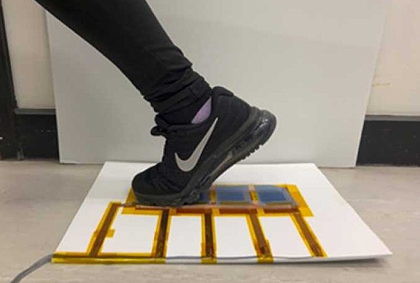- Home » News » Technology News
Stepping on a graphene mat could power sensors

Scottish researchers have produced a pressure-sensitive mat containing a graphene-based material that generates power when humans walk on it. They suggest that the low-cost, energy-efficient technology could be used to power sensors, to monitor building occupancy, or to reduce energy use by, for example, controlling temperatures as people or enter or leave a room.
The researchers, from the Institute of Thin Films, Sensors and Imaging (ITFSI) at the University of the West of Scotland (UWS), have used a 3D graphene foam material called Gii as an active layer in the energy generator. The material is made by a Scottish firm, Integrated Graphene.
For around 20 years, researchers have been investigating the use of triboelectric nanogenerators (Tengs) for converting mechanical energy into usable electrical energy to power not only small devices such as sensors, but also more power-hungry equipment such as drones. However, efforts to produce commercially viable Tengs have, to date, been hampered by issues such as poor durability, limited energy output and poor efficiency.
The Scottish researchers believe that the addition of the Gii material opens up new possibilities because of its properties including a high surface area, porosity, light weight, and good electrical performance. The pressure-sensitive material could be used, for example, to:
• generate power for Industry 4.0 applications;
• harvest energy from people walking along pavements, or vehicles travelling on roads; or
• to power wearable biosensors to diagnose health conditions.
The researchers have published their results in ScienceDirect.
“We’re very excited by these findings,” says Dr Carlos Garcia Nuñez, a lecturer in the UWS School of Computing, Engineering and Physical Sciences. “Through our work with Integrated Graphene, we have proven that using Gii-material – an advanced type of three-dimensional graphene foam – as an active layer in triboelectric nanogenerators (Tengs) can work as a reliable and cost-effective energy-harvesting power source for autonomous sensors and electronics.

“This discovery has enormous potential for the booming global Internet of Things (IoT) industry,” he suggests. “Given the global need for alternative sources of green energy, Gii-Tengs can potentially provide a sustainable source of power for the multitude of small electronic devices which we use in our everyday lives, bringing us one step closer to realising a greener and more energy-abundant future.”
“The possibilities of Gii-Teng are endless, with the potential to push the limits of technology beyond human expectations,” adds Marco Caffio, Integrated Graphene’s chief scientific officer. “With the number of IoT devices interlinked worldwide forecast to reach 100 billion by 2030, there is a clear need for new sustainable energy sources and technologies which can meet the power demand for our reliance on technology for work, life and play.
“Our Gii-Teng platform could potentially prevent the constant replacement of batteries in trillions of devices, and reduce the utilisation of wires, making the IoT technology of the near future wireless and energy-autonomous,” he continues. “We’re excited by its potential and believe it could play a key role in society’s journey towards a smart world.”
Integrated Graphene: Twitter LinkedIn





